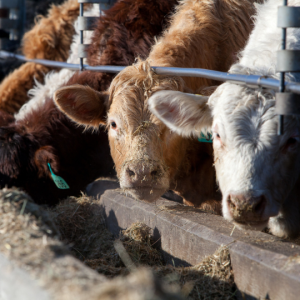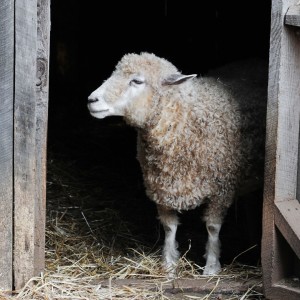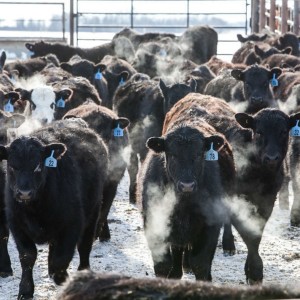CAHSS Podcast Series - Animal Health Insights
The Canadian Animal Health Surveillance System (CAHSS): A shared national vision leading to effective, responsive, integrated animal health surveillance in Canada. Le Système canadien de surveillance de la santé animale (SCSSA): Une vision nationale commune qui mènera à une surveillance efficace, souple et intégrée de la santé animale au Canada.
Episodes

Tuesday May 04, 2021
Tuesday May 04, 2021
Les maladies infectieuses entrent dans un bâtiment d’élevage de la même façon que nous: en passant par la porte! Cette vétérinaire avicole explique comment réduire le risque de maladies en adoptant certains comportements pour réduire le mouvement des agents pathogènes dans les bâtiments d’élevage.
Face à une éclosion de maladie, les vétérinaires recommandent aux éleveurs de rehausser leurs mesures de biosécurité. La biosécurité fait référence aux mesures de protection mises en place pour réduire le risque qu’un agent pathogène tel qu’un virus ou une bactérie entre dans un bâtiment d’élevage et contamine un troupeau. Certaines de ces mesures sont tellement simples qu’il peut être difficile d’imaginer l’ampleur de l’impact positif qu’elles peuvent avoir sur la santé animale.
Quand les vétérinaires parlent de prévention des maladies, ils mentionnent souvent l’importance d’appliquer d’excellentes mesures de biosécurité. La biosécurité fait référence aux mesures de protection mises en place pour réduire le risque qu’un agent pathogène tel qu’un virus ou une bactérie entre dans un bâtiment d’élevage pour contaminer un troupeau. Face à une éclosion de maladie, les vétérinaires recommandent aux éleveurs de rehausser leurs mesures de biosécurité. Certains de ces changements sont tellement simples qu’il peut être difficile d’imaginer l’ampleur de l’impact qu’ils peuvent avoir sur la santé animale.
Dre Geneviève Huard, vétérinaire avicole et chercheure, a travaillé sur un projet qui illustre comment les agents pathogènes peuvent entrer dans un bâtiment d’élevage et quoi faire pour les garder à l’extérieur.
Liens d’intérêt :
Gouvernement du Canada, Biosecurité
Ministère de l'Agriculture, des Pêcheries et de l'Alimentation du Québec, Biosécurité à la ferme
En anglais:
Biosecurity Overview, Penn State Extension
Biosecurity Basics for Poultry Growers, University of Georgia

Tuesday Apr 06, 2021
Tuesday Apr 06, 2021
A veterinarian reveals newly identified biosecurity-related risk factors for introduction of respiratory disease, Johne's disease, and calf diarrhea into beef cow-calf herds in Western Canada.
Biosecurity is one tool that veterinarians and producers use to minimize the chance of any disease exposure to animals on farm, but it is a broad group of principles that can seem difficult to implement correctly in all farming situations. While some disease risks are shared across species, different animals and management systems also have some unique biosecurity factors. Dr. Trent Wennekamp, a veterinarian from Lloydminster, Alberta, and a graduate student in the Department of Large Animal Clinical Sciences at the Western College of Veterinary Medicine, University of Saskatchewan, researched biosecurity practices on cow-calf farms in Western Canada. Dr. Wennekamp uncovered some key biosecurity-related disease risk factors for cow-calf herds, and his work emphasizes just how important biosecurity principles can be to the health of calves and cattle.
Links of Interest:
Biosecurity and bovine respiratory disease on beef operations in western Canada, Dr. Trent R. Wennekamp
Canadian Cow-Calf Surveillance Network (a national expansion of the Western Cow-Calf Surveillance Network
The Canadian Beef Cattle On-Farm Biosecurity Standard

Saturday Mar 06, 2021
Saturday Mar 06, 2021
Good barn ventilation goes a long way to support the respiratory health of ruminants. An agricultural engineer and a large-animal veterinarian explain why ventilation is so important for animal health, and share simple barn improvements to minimize disease.
For animals that are dealing with a contagious disease outbreak, true “social distancing” can be almost impossible to put in place. Veterinarians have to think creatively about all aspects of animal care, including the functionality of their housing, in order to decrease the chance that a group of animals will experience a contagious respiratory infection. Dr. Rex Crawford, a large-animal veterinarian, and Mr. Harold House, an agricultural engineer focused on livestock housing, join us to discuss how barn ventilation systems can help to improve ruminant health. From clinical presentations of respiratory disease and common indications of barn ventilation issues, to retrofits or new barn designs to maximize flock or herd health, there are a number of interesting points to consider to help improve ventilation systems for ruminant housing.
Links of Interest:
Dairyland initiative, University of Wisconsin
Ventilation for Livestock and Poultry Facilities, Ontario Ministry of Food, Agriculture and Rural Affairs
Farm Practices Guide - Ventilation, British Columbia Ministry of Agriculture
Fan Ventilation Principles and Rates, Alberta Lamb Producers
Ventilation in Dairy Production, Alberta Government
Sheep Housing Requirements, Canadian Sheep Federation
Ventilation for Dairy Goat Housing, Ontario Goat
Plans types - Aménagment de bâtiments pour petits ruminants de boucherie, MAPAQ

Wednesday Feb 03, 2021
Coughing Conundrums with Dr. Cheryl Waldner: Animal Health Insights, Ep. 2, Feb. 3 2021
Wednesday Feb 03, 2021
Wednesday Feb 03, 2021
Genomic testing may be the future of respiratory disease management - Dr. Cheryl Waldner outlines a project investigating use of genomic tests to gain a timely pen-level risk assessment, allow for targeted use of antibiotics, and improve the health of feedlot cattle.
Diagnostic tests for respiratory disease are similar in both veterinary and human medicine, and many Canadians have now experienced the naso-pharyngeal swab procedure as part of COVID-19 testing. A common frustration when diagnosing bacterial respiratory infections in veterinary medicine is that sick patients need treatment before diagnostic test results are available. A new research project is underway to investigate how cutting-edge genomic testing can help to guide prudent medication selection, improve time to diagnosis and develop diagnostic strategies to improve calf health in feedlots. Dr. Cheryl Waldner, the NSERC/BCRC Research chair and lead investigator for Genomic Assets in Livestock at the University of Saskatchewan, reviews highlights of this investigation, and shares how this work may assist in the global battle against antimicrobial resistance.
Links of Interest:
Genomic ASSETS ((Antimicrobial Stewardship Systems from Evidence-Based Treatment Strategies) for Livestock Research Project page
More information on Dr. Waldner and her work at the University of Saskatchewan
Photo credit: Christina Weese

Wednesday Dec 16, 2020
Wednesday Dec 16, 2020
An infectious disease specialist and a veterinary epidemiologist discuss zoonotic disease risks and the benefits of integrating a One Health approach to veterinary and human medical practice.
The recent pandemic highlights the risks associated with animal - human disease transmission (zoonosis). Dr. Martha Fulford, a medical doctor and specialist in Infectious Diseases from McMaster University, and Dr. Jane Parmley, a veterinary epidemiologist and associate professor in the Department of Population Medicine at the Ontario Veterinary College, University of Guelph, join us to discuss the importance of zoonosis to the current medical landscape, the variety of ways that veterinarians and medical doctors discuss zoonotic diseases with their clients and patients, and how a One Health approach to medicine can help us to meet future disease challenges.
Links of Interest:
Centre for Disease Control Information on Zoonotic Diseases
Worms and Germs Blog
Community for Emerging and Zoonotic Diseases

Wednesday Sep 16, 2020
SCSSA Plan stratégique 2020-2025 (FR)
Wednesday Sep 16, 2020
Wednesday Sep 16, 2020
Plan stratégique 2020-2025 pour consultation des membres du Système canadien de surveillance de la santé animale

Wednesday Sep 16, 2020
SCSSA Charte (FR)
Wednesday Sep 16, 2020
Wednesday Sep 16, 2020
Charte pour consultation des membres du Système canadien de surveillance de la santé animale

Wednesday Sep 16, 2020
CAHSS Governance Charter (EN)
Wednesday Sep 16, 2020
Wednesday Sep 16, 2020
Governance charter for consultation with Canadian Animal Health Surveillance System members



